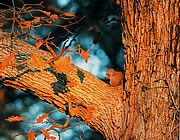
Chris Young SJR When settlers began to develop central Illinois into an agricultural community, they changed the face of the tallgrass prairie. They plowed the prairie soils into farmland and planted crops. They grazed livestock and built homes and small towns. The town of Springfield was developed on prairie land. As Springfield grew in size from a small town to a state capital, Mr. Lincoln’s home and neighborhood were built. Today, the tallgrass prairie is not an evident part of Lincoln Home. The site reflects the area during Mr. Lincoln’s residency, from 1844 – 1861. There are some wildflowers growing in the neighborhood that would have existed on the prairie, such as, coreopsis (Coreopsis verticillata), bur oak (Quercus macrocarpa), and wild strawberry (Fragraria virginianus), but overall, the prairie is not a feature of Lincoln Home National Historic Site. |
Last updated: April 10, 2015
